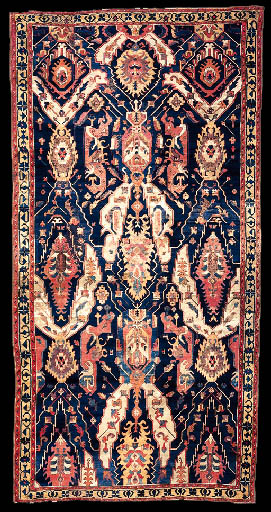A CAUCASIAN DRAGON CARPET
LATE 18TH CENTURY
Price Realized £34,500 ($58,747)
Sale Information
Christie's Sale 6030
CARPETS
15 October 1998
London, King Street
Lot Description
272-A CAUCASIAN DRAGON CARPET
LATE 18TH CENTURY
The shaded indigo field with three columns of large stylised polychrome
serrated palmettes linking bold serrated diagonal panels in white and
sea-blue forming irregular shaped panels enclosing small floral motifs
around stylised polychrome dragons, in a narrow sandy yellow border of
angular palmette and vine between red spiralling ribbon stripes, slight
wear, areas of repiling, smaller areas of restoration
12ft.6in. x 6ft.3in. (382cm. x 191cm.)
Warp: wool, ivory, Z2S
Weft: wool, ivory, Z2S; 3 shoots
Pile: wool, Z2S; symmetric, H40 x V42
Provenance
Anon. sale, Sotheby's London, 14 October 1977, lot 2.
E. Cittone, Milan
Literature
Dall'Ogio, Marino: 'A White Ground Dragon Carpet: a study of the design and
relevant comparisions, HALI Vol.II, no.1, Spring 1978, pl.7, p.18.
Exhibited
Pope, A. U.: Catalogue of a Loan Exhibition of Early Oriental Carpets,
Chicago 1926, no.32.
Lot Notes
Alongside the main group of Caucasian dragon carpets, an early example of
which is included in the Alexander Collection section of this sale, lot 222,
is a group of carpets of similar design but different structure. This was
discussed by Marino Dall'Oglio using a white ground carpet in the Wher
Collection as a starting point. This group is typified by thinner yarns,
usually a cotton or silk foundation, and a lack of weft cables, resulting in
a much softer more pliable weaving. The best of the group, on a black
ground, now in the Metropolitan Museum of Art, was formerly in the McMullan
Collection (McMullan, Joseph V.: Islamic Carpets, New York, 1965, no.39,
p.160-161). The drawing on that carpet contains all the elements seen in the
dragon carpets such as the Alexander piece, indicating an early date. It is
therefore thought that this small group (dall'Oglio lists six in all, of
which the present example is one) was made contemporaneously with the main
group, but in a different centre, probably further north-east in the
Caucasus, possibly in the Shirvan region. |


